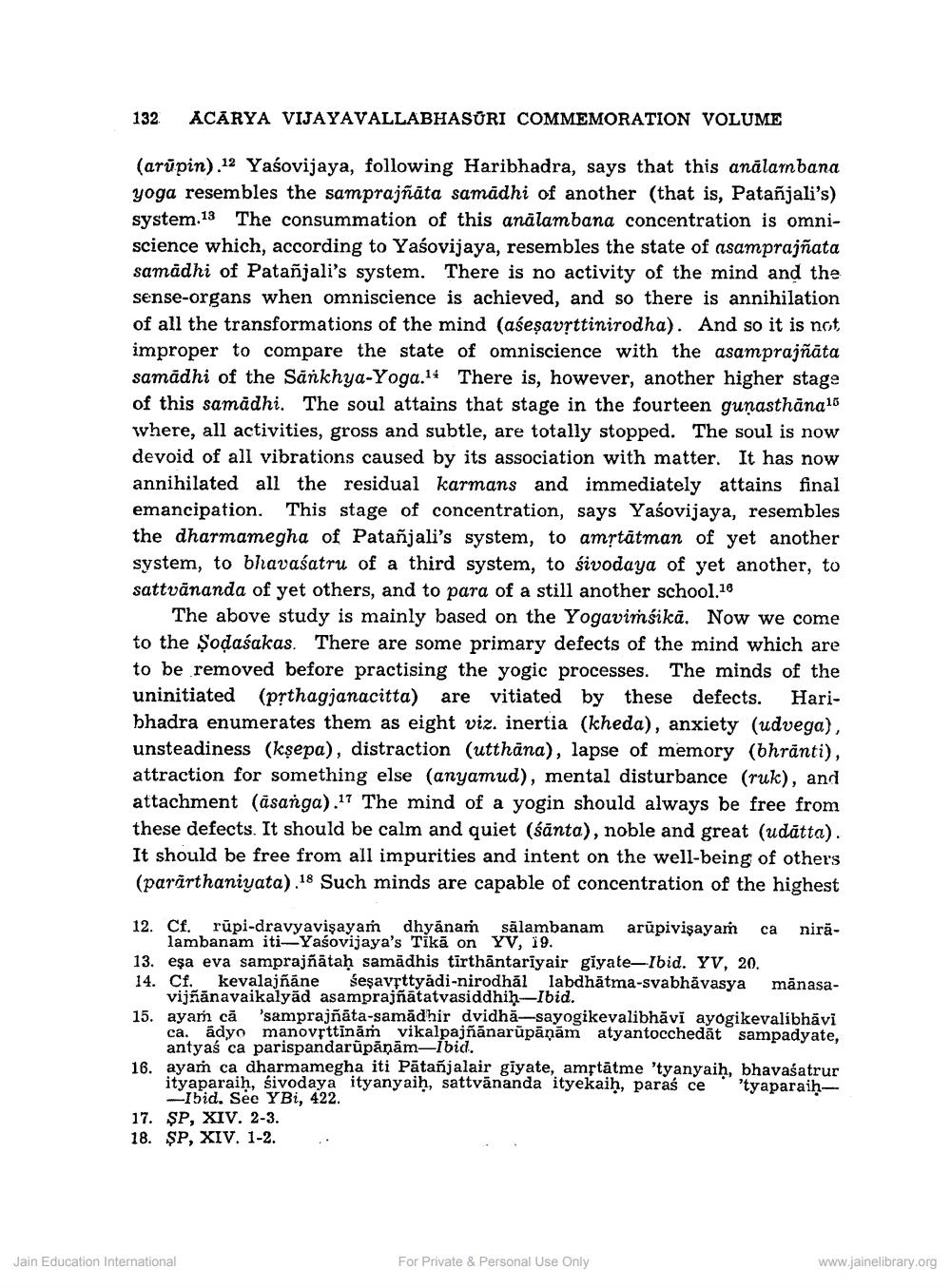________________
132 ACARYA VIJAYAVALLABHASŰRI COMMEMORATION VOLUME
(arūpin). 12 Yaśovijaya, following Haribhadra, says that this anālambana yoga resembles the samprajñāta samadhi of another (that is, Patañjali's) system.13 The consummation of this analambana concentration is omniscience which, according to Yaśovijaya, resembles the state of asamprajñata samadhi of Patañjali's system. There is no activity of the mind and the sense-organs when omniscience is achieved, and so there is annihilation of all the transformations of the mind (aśeşavṛttinirodha). And so it is not improper to compare the state of omniscience with the asamprajñāta samadhi of the Sankhya-Yoga.14 There is, however, another higher stage of this samadhi. The soul attains that stage in the fourteen gunasthāna15 where, all activities, gross and subtle, are totally stopped. The soul is now devoid of all vibrations caused by its association with matter. It has now annihilated all the residual karmans and immediately attains final emancipation. This stage of concentration, says Yaśovijaya, resembles the dharmamegha of Patañjali's system, to amrtātman of yet another system, to bhavasatru of a third system, to śivodaya of yet another, to sattvānanda of yet others, and to para of a still another school.18
The above study is mainly based on the Yogaviņģikā. Now we come to the Sodasakas. There are some primary defects of the mind which are to be removed before practising the yogic processes. The minds of the uninitiated (prthagjanacitta) are vitiated by these defects. Haribhadra enumerates them as eight viz. inertia (kheda), anxiety (udvega), unsteadiness (kşepa), distraction (utthāna), lapse of memory (bhränti), attraction for something else (anyamud), mental disturbance (ruk), and attachment (äsanga).17 The mind of a yogin should always be free from these defects. It should be calm and quiet (santa), noble and great (udatta). It should be free from all impurities and intent on the well-being of others (pararthaniyata).18 Such minds are capable of concentration of the highest
12. Cf. rūpi-dravyavisayam dhyanam sālambanam arūpivişayam ca nirä
lambanam iti-Yaśovijaya's Tikā on YV, 19. 13. esa eva samprajñātaḥ samādhis tirthāntariyair giyate-Ibid. YV, 20. 14. Cf. kevalajñāne sesavrttyadi-nirodhāl labdhätma-svabhāvasya mānasa
vijñānavaikalyād asamprajñātatvasiddhih-Ibid. 15. ayam că 'samprajñāta-samādhir dvidh-sayogikevalibhavi ayogikevalibhavi
ca. ädyo manovrttinām vikalpajñānarūpāņām atyantocchedāt sampadyate,
antyaś ca parispandarūpāņām-Ibid. 16. ayam ca dharmamegha iti Patañjalair giyate, amptātme 'tyanyaih, bhavaśatrur
ityaparaih, śivodaya ityanyaiḥ, sattvänanda ityekaiḥ, paraś certyaparaih
-Ibid. See Y Bi, 422. 17. SP, XIV. 2-3. 18. SP, XIV. 1-2.
Jain Education International
For Private & Personal Use Only
www.jainelibrary.org




